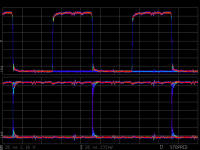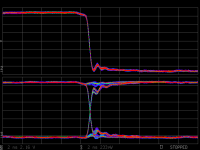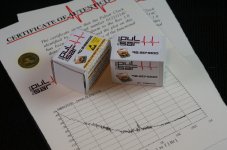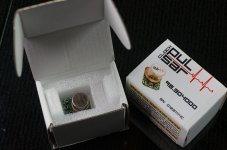384/fifo
Glad, thanks to you persistent effort, Lorian could solve this issue!
My problem is solved.
Thanks to the www for letting people meet, resulting in more understanding and solutions.(Are these my words???....anyhow, you know what I mean, or dont't you?)
Back to the music now,
Ed
I upgraded my WaveIO USB with Lorien’s new sent FW last weekend and confirmed it works. The new FW has 17ns setup time on I2S signals rather than the previous 3.4ns. As well, LRCK and SD are changing exactly at the moment of falling edge of SCK now which meets the requirement of I2S BUS specification. The 384KHz issue was fixed, which just as I said, the solution1 is the best solution.
It works very well, even together with the on-board isolator and the I2S backdoor of the S/PDIF interface board. The music plays very nice at 384KHz, no any noise at all.
The attached screen shots are current measured waveform of WAVEIO USB running at 384KHz with new FW.
Please refer to the old waveform here to find out what’s the difference:
http://www.diyaudio.com/forums/digi...mate-weapon-fight-jitter-340.html#post4038295
Ian
Glad, thanks to you persistent effort, Lorian could solve this issue!
My problem is solved.
Thanks to the www for letting people meet, resulting in more understanding and solutions.(Are these my words???....anyhow, you know what I mean, or dont't you?)
Back to the music now,
Ed
Last edited:
Thats great news, Ian.
Can you confirm which version FW you are using and when it was released?.
Regards,
Shane
It was the beta version I think. You can ask Lorien for the released version.
Regards,
Ian
Hi Ian,
been keeping an eye out for announcements.
I am still very keen on your FIFO project. I need to process 3 x sets of signals to 1x ESS9018 and 2 x ESS9023 DACs.
happy to buy 3 individual FIFO boards, or one of your multi-channel FIFOs.
can you help?
Brad
Thank you for your interesting and your patience. I don't have any FIFO KIT left, even the PCB. So I have to run another production. I'll try my best, just hope I'm not that busy
Regards,
Ian
Fix 384KHz issue(10): Case can be closed
Small issue, quite a few homework. But fortunately it seems the case can be closed now.
Just hope not too much confusing, some sum up here:
1. Insufficient setup time of I2S output signals was the reason of old XMOS 384KHz issue.
2. This issue can be fixed by upgrading XMOS USB to the new firmware which will generate I2S signal exactly up to i2S BUS specification.
3. The issue can also be solved by adding 5-10ns delay to SCK(BCK) signal with hardware.
The attached waveform is the finial 384KHz PCM signal (will feed into TDA1541DAC) measured at output of PCM board after FIFO in my system (Under same testing condition).
Ian
Small issue, quite a few homework. But fortunately it seems the case can be closed now.
Just hope not too much confusing, some sum up here:
1. Insufficient setup time of I2S output signals was the reason of old XMOS 384KHz issue.
2. This issue can be fixed by upgrading XMOS USB to the new firmware which will generate I2S signal exactly up to i2S BUS specification.
3. The issue can also be solved by adding 5-10ns delay to SCK(BCK) signal with hardware.
The attached waveform is the finial 384KHz PCM signal (will feed into TDA1541DAC) measured at output of PCM board after FIFO in my system (Under same testing condition).
Ian
Attachments
Last edited:
Thank you for your interesting and your patience. I don't have any FIFO KIT left, even the PCB. So I have to run another production. I'll try my best, just hope I'm not that busy.
Regards,
Ian
I'm waiting with much anticipation and hope Ian for the next GB!
90.3168/98.3040MHz OCXO
The pair of OCXO I ordered arrived last week. Very expensive though. The pair I evaluated was the best impressed so far, I couldn’t live without it. That’s the reason I must buy them. Just hope they are better, or at least, as same as those prototypes.
It seems I have to design a new Dual XO clock board the next to support 90/98 MHz audio clocks. According to my listening test, both ESS9018 DAC and other multi-bits DAC which connects to PCM board, sound better than with 40/45 MHz clocks under same test condition.
Have a good weekend
Ian
The pair of OCXO I ordered arrived last week. Very expensive though. The pair I evaluated was the best impressed so far, I couldn’t live without it. That’s the reason I must buy them. Just hope they are better, or at least, as same as those prototypes.
It seems I have to design a new Dual XO clock board the next to support 90/98 MHz audio clocks. According to my listening test, both ESS9018 DAC and other multi-bits DAC which connects to PCM board, sound better than with 40/45 MHz clocks under same test condition.
Have a good weekend
Ian
Attachments
Hi Ian, will the new Dual XO board accept only the OCXO clocks or also the old ones? I'm hoping for both.
Many thanks,
BK
Yes, of coures, the new Dual XO clock board will support both this new OCXO and all other regular XOs
Regards,
Ian
The pair of OCXO I ordered arrived last week. Very expensive though. The pair I evaluated was the best impressed so far, I couldn’t live without it. That’s the reason I must buy them. Just hope they are better, or at least, as same as those prototypes.
It seems I have to design a new Dual XO clock board the next to support 90/98 MHz audio clocks. According to my listening test, both ESS9018 DAC and other multi-bits DAC which connects to PCM board, sound better than with 40/45 MHz clocks under same test condition.
Have a good weekend
Ian
Very nice Ian,I wanted to order a Pulsar @ 45MHZ,do you intend to quickly produce new XO board?can you define the difference that may exist between 45-49MHZ and 90-98MHZ please.
Very nice Ian,I wanted to order a Pulsar @ 45MHZ,do you intend to quickly produce new XO board?can you define the difference that may exist between 45-49MHZ and 90-98MHZ please.
I'm gonna design the new Dual XO II clock board very soon. I'm trying to supply it at next GB.
I compared them with CCHD957 40/45 a couple of month ago, better result. But I don't have 45/49 OCXO. I would suggest you order the 90/98 version.
Regards,
Ian
Last edited:
Thank Ian,apart from the support of the frequencies 90-98,projects further improvements on the XO board.
Yes, there will be some other improvements for sure.
Ian
I'm gonna design the new Dual XO II clock board very soon. I'm trying to supply it at next GB.
I compared them with CCHD957 40/45 a couple of month ago, better result. But I don't have 45/49 OCXO. I would suggest you order the 90/98 version.
Regards,
Ian
And where do your last clock board compare in all this?
//
May it is possible finally to do less pcbs to reduce costs and delay and increase quality with a unique or two pcb/concept in relation to the quality parts and the goals of the diyers ? And the little time you have for manage commodities (shipments, send productions in several little quantities, etc !)
Why not less connectors and options to reduce (maybe, don't know as no technician myself but on the waiting list) time and length problems (jitter, length inteconects, delay of supplying and TCO about diyer and supply chain on your side) ?
Certainly poll must be maid about the cost diyers could spend but you seem to go with a no compromise design goal ! So all in one : near SOTA LDOs, simultaned mode for the best PCM chips and also options for the best modern one as you do with ES9018.
A compromise wisch will be to think about future for the inputs : I need a bad spidf because Squeze Box, but the future seems to be more WIFI bufered or RJ45 inputs, or why not a all in one with simple SD card high capacity or HDD bufered on the pcbs !
A dream...just two cents if the costs should increase with no compromise parts as new crystals...
Why not less connectors and options to reduce (maybe, don't know as no technician myself but on the waiting list) time and length problems (jitter, length inteconects, delay of supplying and TCO about diyer and supply chain on your side) ?
Certainly poll must be maid about the cost diyers could spend but you seem to go with a no compromise design goal ! So all in one : near SOTA LDOs, simultaned mode for the best PCM chips and also options for the best modern one as you do with ES9018.
A compromise wisch will be to think about future for the inputs : I need a bad spidf because Squeze Box, but the future seems to be more WIFI bufered or RJ45 inputs, or why not a all in one with simple SD card high capacity or HDD bufered on the pcbs !
A dream...just two cents if the costs should increase with no compromise parts as new crystals...
Last edited:
And where do your last clock board compare in all this?
//
To do the test, I modified one of my Dual XO clock board temporarily. I posted it time ago. Try to search it, maybe you can still find some thing related.
Regards,
Ian
I meant the Si570 Clock Board... How do you rate that one?
I did careful compare in between, the OCXO is better than Si570.
Ian
- Home
- Source & Line
- Digital Line Level
- Asynchronous I2S FIFO project, an ultimate weapon to fight the jitter



